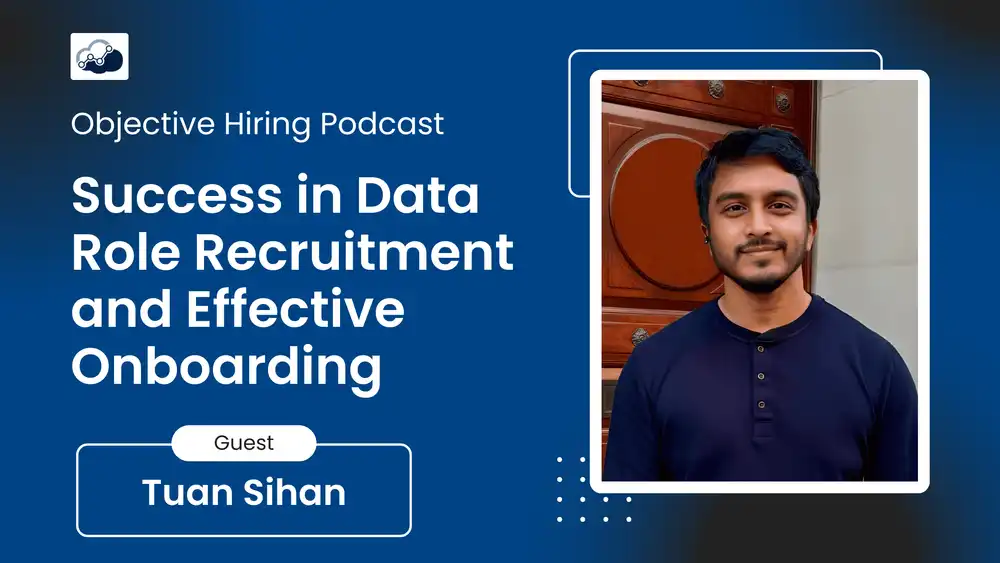Tuan Sihan on Hiring for Potential Over Pedigree in Data Roles

Tuan Sihan on Hiring for Potential Over Pedigree in Data Roles
On a recent episode of the Objective Hiring podcast, Tuan Sihan, Head of Data & AI at Aspect, joined Tim Freestone, founder of Alooba, to challenge conventional hiring wisdom in data teams.
Rather than focusing on technical skills or pedigree, Tuan prioritises curiosity, coachability, and a strong personal drive.
“My success has been much greater when I hire people just because of their personality… people who are ambitious, people who have a vision or a goal towards data.”
Tuan’s approach has delivered impressive results. He’s hired data analysts with no previous experience who are now ready to manage teams within a year. According to him, the difference isn’t technical skill—it’s motivation and structured support.
Soft Skills Over Tools
Tuan openly critiques the overemphasis on technical tools in hiring.
“Any hard skill, any tool can be taught or learned. But the soft skills—those need to be earned.”
In his view, what truly matters is a candidate’s ability to communicate, show curiosity, and integrate with the team. Many technically capable candidates fall short because they fail to articulate their value.
“They get lost in the rabbit hole of trying to show how amazing they are at Python and SQL… but they’re not able to explain how that helped the business.”
The Case Against Standardised Testing
While many companies rely on skills tests, logic puzzles, or IQ assessments, Tuan takes a very different view.
“These are potentially the worst way of identifying the best candidate you can hire.”
He’s sceptical of pre-built generic tests and has seen too many cases where great candidates are eliminated for failing exercises that don’t reflect their actual capability.
Instead, he believes the hiring process should centre around real conversations and practical demonstrations of soft skills and motivation.
Structured Onboarding That Works
Tuan has created a detailed onboarding process to support junior hires. It includes a career roadmap, hands-on training, and collaborative project work.
“I show them the schema, the tools, and say: here’s how to learn step one, two, three.”
This investment pays off. By the second week, he’s already able to evaluate their strengths. From there, he adapts tasks and team roles based on individual profiles—pairing creative types with more analytical teammates for balanced outcomes.
“Collaboration is the greatest factor in delivering the best projects.”
Planning Before Posting
Many hiring managers think onboarding begins once someone starts the job. Not Tuan. He maps out deliverables and expectations before writing the job description.
“I need to know what I would expect out of someone I’m hiring before I even think of having the post up.”
This ensures he hires the right person and can set them up for success.
A Model for New Managers
Tuan offers clear advice to anyone hiring data talent for the first time:
- Remember what it’s like to be new.
- Never assume someone knows something just because it’s obvious to you.
- Create documentation.
- Invest early, save time later.
“Once you have the onboarding document in place, you can use the same process again. It’s sustainable.”
Hiring With Intention
Tuan’s approach is about hiring deliberately—not based on gut feel, nor over-engineered systems. He spends time reviewing CVs, looks at LinkedIn profiles to assess personal branding, and always follows up with personalised messages.
“I saw X thing in your profile that really stood out to me… let’s chat.”
While he acknowledges this doesn’t scale for thousands of applicants, he sees huge benefits in taking a hands-on approach—at least at the screening stage.
A Soft Sell for Skills-Based Hiring
For teams wanting to remove bias, improve hiring speed, or better evaluate real skills, tools like Alooba offer a balanced approach—combining data, structured interviews, and customisable assessments. Sign up here to start hiring with confidence.
“What I wish is that I could see someone’s personality and charm in one window… before I even talk to them.”
In Tuan’s ideal world, we’d stop filtering for proxies (like schools or tool experience) and start focusing on what people are truly capable of doing.
Developing Talent From Within
One of the benefits Tuan highlights about hiring for potential is the ability to shape talent from the ground up. Rather than unlearning bad habits or reshaping fixed mindsets, new hires can grow organically within the team's existing practices and culture.
He shares how junior team members he hired are now training others—a testament to the compound effect of this method.
“My team has come to a position where they can now train the rest. Even people who’ve moved on still thank me for that onboarding.”
This also creates internal role models for new hires, setting a positive precedent.
Why This Approach Isn’t Just Idealistic
Sceptics might argue this approach sounds idealistic, especially in high-pressure environments. But Tuan counters that by planning early, setting expectations, and structuring onboarding, the risk is significantly reduced.
He knows what he wants his team to achieve and builds backwards from that outcome.
“I don’t just hire and hope. I plan what I expect out of the person before I even post the role.”
Hiring for personality with structured onboarding isn’t just a feel-good strategy—it’s efficient.
Final Thoughts
Tuan’s model flips the traditional hiring script. It’s not about who’s the best on paper or who aces the test. It’s about finding people who want to grow, and giving them the structure and support to do it.
For hiring managers looking to future-proof their team, it might be time to rethink what really makes a strong candidate.